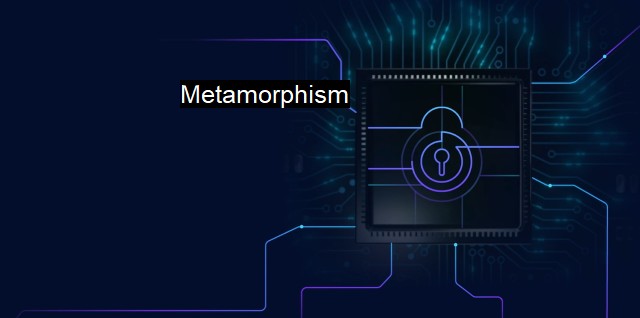What is Metamorphism?
Metamorphism in Cybersecurity: Understanding the Advanced Techniques Employed by Malware Threat Actors to Evade Detection and the Role of Antivirus
Metamorphism is a security concept that is crucial to cyber security and antivirus protection. This term, originating from geology, describes the process where heated or pressured rocks undergo physical or chemical change without melting, transforming into new rocks. In terms of cyber security, metamorphism refers to different, yet ominously similar process that malicious programs use to change their appearance without altering their payload.The idea is simple but remarkably effective and dangerous. The malicious code alters its own structure without disturbing its original function. This means that the virus, worm, or other piece of malware can continually adapt in an effort to avoid detection. Metamorphism makes malware codes appear differently each time their host systems are run, generating hundreds even thousands of unique instances of a single malicious code. This allows malware to adapt to its environment and evade detection by many standard defenses. Consequently, a single virus has the potential to create a wide range of unique attacks.
Metamorphic malware operates on the concept of rewriting its own code so that functionally remains identical, but structurally is altered extensively enough so that it appears to be an entirely different program. This is achieved through various techniques like code permutation, register renaming, garbage code insertion, subroutine reordering, instruction substitution and many more. it generates myriad manifestations of a single program’s payload, thereby potentially bypassing simple identification checks by antivirus solutions.
One of the key concerns of any antivirus software is to detect virus signatures—a unique string of bytes used to identify specific malware. metamorphic viruses pose significant challenges due to their ever-adapting nature. The complexities of deciphering a code that changes adjusts and modifies whenever it is confronted is astounding.
This complexity is further compounded by the use of obfuscation techniques. Malware authors often leverage a multi-level approach to obfuscation which aids the metamorphism. They use polymorphic and metamorphic techniques to morph the malicious code into an irrecognizable pattern, completely different from the original version. Think of it as a wildlife changer, which alters its color, shape, and pattern to adapt to its surroundings and elude predators.
These elusive characteristics of metamorphic malware pose a significant threat to digital security. It makes the role of an antivirus incredibly challenging, as it has to work beyond just recognizing predetermined virus signatures. The antivirus software has to invest a lot into heuristic scanning, which involves analyzing the software's behavior and code in-depth, looking for anything suspicious even if it’s not associated with a known threat.
In this digital age when metamorphic malware is becoming increasingly common and sophisticated, monitoring for morphing malware is a daunting task. The evolution of malware has also led to the evolution of protections against it. There is a constant need for improvement in existing systems that predict, prevent, detect, and remove threats from these metamorphic viruses. New techniques such as data mining, machine learning, code analysis, and behavior prediction models are frequently being adopted into the proactive defense systems.
To sum up, metamorphism is a growing threat in the realm of cybersecurity. The continuous metamorphosis of these viruses makes it extremely difficult for security solutions to detect and neutralize them. The adaptable, elusive nature of these threats requires perpetually evolving cybersecurity measures. Therefore, advanced defensive strategies must include mechanisms capable of identifying potential clusters of malicious behavior and patterns, irrespective of the fundamental binary or code constructs thereby, striking a real blow to the metaphor. It seems that to adeptly combat the artful dodging technique of cyber threats, defense mechanisms may also require an aspect of metamorphosis themselves.

Metamorphism FAQs
What is metamorphism in the context of cybersecurity and antivirus?
Metamorphism refers to the technique used by malware to constantly change its code to avoid detection by antivirus programs. This technique involves altering the code of the malware each time it infects a new system, making it difficult for antivirus software to detect and remove it.How does metamorphism help malware evade detection by antivirus programs?
Metamorphism allows malware to obfuscate its code at runtime, making it difficult for antivirus software to detect the malware's signature. The malware modifies its code as it runs, making it virtually impossible for antivirus software to identify and block it.How can organizations protect themselves against malware that uses metamorphism?
To protect against malware that uses metamorphism, organizations should use antivirus software that employs advanced detection techniques such as behavior-based analysis, sandboxing, and machine learning. Additionally, organizations should regularly update their antivirus software and maintain robust cybersecurity practices, including employee training and awareness.Are there any limitations to the effectiveness of antivirus software against malware that uses metamorphism?
While antivirus software has become increasingly effective in detecting and blocking malware that employs metamorphism, there are still limitations to its effectiveness. As malware continues to evolve and become more sophisticated, antivirus software must constantly adapt to keep up with the latest threats. Additionally, some malware may be designed specifically to evade detection by antivirus software, making it more difficult to detect and remove.Related Topics
Signature-based Detection Code Obfuscation Dynamic Analysis Static Analysis Heuristic Analysis
| | A | | | B | | | C | | | D | | | E | | | F | | | G | | | H | | | I | | | J | | | K | | | L | | | M | |
| | N | | | O | | | P | | | Q | | | R | | | S | | | T | | | U | | | V | | | W | | | X | | | Y | | | Z | |
| | 1 | | | 2 | | | 3 | | | 4 | | | 7 | | | 8 | | |||||||